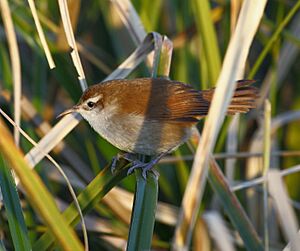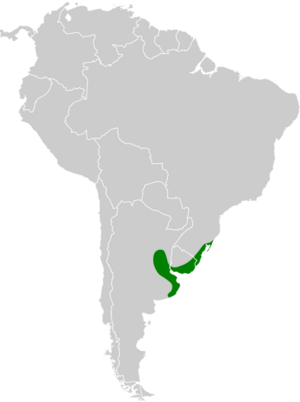Curve-billed reedhaunter facts for kids
Quick facts for kids Curve-billed reedhaunter |
|
|---|---|
 |
|
| at Montevideo, Uruguay. | |
| Conservation status | |
| Scientific classification | |
| Genus: |
Limnornis
|
| Species: |
curvirostris
|
 |
|
The curve-billed reedhaunter (Limnornis curvirostris) is a cool bird that lives in Argentina, Brazil, and Uruguay. It belongs to the ovenbird family called Furnariidae. This bird is known for its special curved beak, which helps it find food in marshy areas.
Contents
About the Curve-billed Reedhaunter
How Scientists Classify This Bird
For a long time, people thought the curve-billed reedhaunter was very closely related to the straight-billed reedhaunter. Some even thought they were in the same group! But scientists used new tools, like studying their genes, in the early 2000s. These studies showed that the two birds are actually not that close.
It turns out the straight-billed reedhaunter is more like the spinetails, another group of birds. The curve-billed reedhaunter is actually most closely related to the wren-like rushbird. The curve-billed reedhaunter is the only bird in its specific group, or genus, called Limnornis. It doesn't have any different types or subspecies.
What Does It Look Like?
The curve-billed reedhaunter is a small bird, about 15 to 17 centimeters (6 to 7 inches) long. It weighs around 27 to 30 grams (about 1 ounce), which is like a few pieces of candy! Its feathers look a lot like some reed warblers found in other parts of the world.
This bird has a long beak that curves downwards quite a bit. Both male and female birds look the same. They have a whitish stripe above their eye, like an eyebrow. There's a dark brown band behind their eye. Their cheeks are whitish.
The top of their head, neck, back, and tail feathers are a rich brown color. The brown is darkest on their head and gets a bit more reddish towards their tail. Their wings and tail are also reddish-brown. Their throat is whitish, and their chest is a bit buffy (light yellowish-brown). Their belly is creamy, and their sides are cinnamon-buff.
Their eyes are brown. Their upper beak is brown to blackish, and their lower beak is a mix of whitish and brownish. Their legs and feet are grayish.
Where Does It Live?
You can find the curve-billed reedhaunter in the southern part of Brazil, in southern Uruguay, and in eastern Argentina. It loves to live in freshwater marshes. Sometimes, it can also be found in slightly salty marshes, like those near the coast.
These areas often have tall plants like giant sedge and certain types of grass. This bird usually lives near the coast, from sea level up to about 100 meters (330 feet) high.
How the Curve-billed Reedhaunter Behaves
Staying in One Place
The curve-billed reedhaunter doesn't travel far. It stays in the same areas all year round.
What It Eats
This bird eats different kinds of arthropods, which are like insects and spiders. It finds them by picking them off the marsh plants. It usually looks for food by itself.
Building a Home and Raising Chicks
Scientists believe the curve-billed reedhaunter builds its nests during the spring and summer in the Southern Hemisphere. They also think that one male and one female bird stay together to raise their young.
The nest is shaped like a ball and is made from grass, leaves, and other plant fibers. Inside, it's lined with softer plant material to make it cozy. The nest has an entrance on the side, often with a little "awning" or overhang above it. The bird attaches its nest to reeds or other plants in the marsh. They usually lay two eggs. We don't know exactly how long the eggs take to hatch or when the young birds leave the nest. We also don't know much about how the parents care for their babies.
Its Song and Calls
The curve-billed reedhaunter's song is a "fast series of harsh notes." It starts high, then goes lower in pitch, and fades away at the end. When it makes a call, it sounds like a hollow "took."
Its Conservation Status
The IUCN (International Union for Conservation of Nature) first thought the curve-billed reedhaunter was "Near Threatened." But since 2004, they have changed its status to "Least Concern." This means they are not worried about it disappearing anytime soon.
Even though it lives in a specific area and we don't know exactly how many there are, its population seems to be stable. There aren't any big threats to it right now. It is thought to be somewhat uncommon. It lives in some protected areas, but because it needs very specific marsh habitats, it could be vulnerable if those habitats change.


